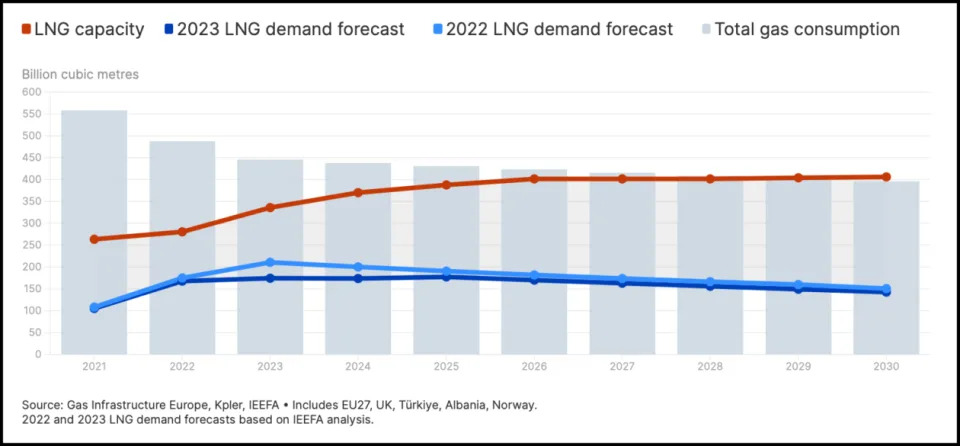Samantha Bergeson
Wed, November 1, 2023

Tom Cruise has saved cinema, and now, maybe the United States?
Cruise’s “Mission: Impossible – Dead Reckoning Part One” franchise installment allegedly inspired President Joe Biden to issue an executive order for new security measures involving artificial intelligence.
Deputy White House chief of staff Bruce Reed told the Associated Press that the president became more concerned over AI threats after watching the film, directed by Christopher McQuarrie.
“If he hadn’t already been concerned about what could go wrong with AI before that movie, he saw plenty more to worry about,” Reed said.
“Mission: Impossible – Dead Reckoning Part One” follows Cruise’s Ethan Hunt as he battles the Entity, a sentient AI program that infiltrates every possible security program on an international scale.
Both Reed and Biden watched the movie at Camp David. Reed noted that, additionally, Biden was “impressed and alarmed” after seeing “fake AI images of himself” and discovering the “terrifying technology of voice cloning.”
“Biden was profoundly curious about the technology in the months of meetings that led up to drafting the order,” Reed said, adding that the president met with scientists that explained the possible uses of AI.
The executive order will direct “the most sweeping actions ever taken to protect Americans from the potential risks of AI systems,” including developing standards, tools, and tests to ensure safety in AI systems and requiring AI developers to share their safety test results and other information with the U.S. government. The order also directs guidance for “content authentication and watermarking to clearly label AI-generated content” to protect against fraud via AI.
The uses of AI are currently part of the ongoing SAG-AFTRA strike negotiations with the AMPTP, as well as being a key issue in the now-resolved WGA strike. Directors Christopher Nolan and Nicolas Winding Refn have spoken out about the use of ChatGPT and other AI tools in the landscape of filmmaking.
Refn exclusively told IndieWire that ChatGPT will “shut down” any content deemed “controversial or themes that are not acceptable anymore.”
“So for me, it’s almost like if your work is approved by a chat, that’s a great alert system to rewrite,” Refn said. “It was very interesting trying it because I thought I was going to use it creatively, but I really ran into always disagreeing with it. So I just stopped using it, and that was that.”
The White House just revealed a key factor driving Biden’s new order to rein in AI: The latest Tom Cruise ‘Mission: Impossible’ movie
Paige Hagy, Rachyl Jones
Wed, November 1, 2023

Hollywood action star Tom Cruise has long been a powerhouse at the box office, with Top Gun: Maverick grossing more than $1.4 billion worldwide and the Mission Impossible franchise grossing more than $4 billion. Now, his influence has extended to the White House.
President Joe Biden watched Cruise’s newest movie, Mission: Impossible — Dead Reckoning Part One, at Camp David recently. The film’s antagonist is a sentient, rogue AI known as “the Entity,” and it helped inspire Biden to sign an executive order on Monday establishing guardrails for artificial intelligence.
“If he hadn’t already been concerned about what could go wrong with AI before that movie, he saw plenty more to worry about,” Bruce Reed, White House deputy chief of staff who watched the film with Biden, told the Associated Press.
The executive order will require leading AI developers—like tech giants Google, Microsoft, and Amazon—to share their safety test results and other information with the government. The order also establishes rigorous standards for testing the security of AI, sets guidance for clearly identifying and labeling AI-generated content, and protects people from their data being used to train AI without their knowledge.
It’s unclear when Biden actually watched the Mission: Impossible sequel, which premiered on July 12. But the executive order was months in the making and the president was both “impressed and alarmed” by the technology prior to watching the movie, according to Reed.
“He saw fake AI images of himself, of his dog. He saw how it can make bad poetry. And he’s seen and heard the incredible and terrifying technology of voice cloning, which can take three seconds of your voice and turn it into an entire fake conversation,” Reed said.
'We can’t move at a normal government pace'
In recent months, tech and ethics leaders have called on the White House to take action on the new technology. In one such meeting with Washington officials earlier this year, some of the most powerful voices in AI—including OpenAI CEO Sam Altman, Microsoft CEO Satya Nadella, and Google CEO Sundar Pichai—discussed the risks and benefits of the technology and the need for safeguards.
The Biden administration previously secured voluntary commitments from Big Tech companies to share AI safety information and published the outline for an “AI Bill of Rights” to guide the design and use of AI systems, but Monday’s order was the first with real legal power. Under the executive order, which is enforceable as law, the government can sue companies that don’t share safety test results and other information. Consumers can expect to see additional regulations resulting from the order, experts told Fortune.
Tech is especially difficult to regulate because innovations in the quickly moving industry often outpace the legislation. Biden’s executive order is vague at times—saying the government will “develop tools” without disclosing what they are—but that’s in recognition of the quickly advancing technology, experts told Fortune. If Biden listed specific goals in his order, they might be outdated by the time the government achieves them. By keeping the language fuzzy, the administration can continue to deliver on promises it made in the Monday order as AI technologies evolve.
“We can’t move at a normal government pace,” White House Chief of Staff Jeff Zients said Biden told him, the AP reported. “We have to move as fast, if not faster than the technology itself.”
Joe Biden Felt More Pressure to Create AI Safeguards After Watching the New “Mission: Impossible”
Virginia Chamlee
Wed, November 1, 2023
The president's ambitious executive order on artificial intelligence came after seeing false images of himself online — and watching the AI villain in 'Mission: Impossible — Dead Reckoning Part One'

Jonathan Ernst - Pool/GettyJoe Biden
President Joe Biden's ambitious executive order on artificial intelligence came about in part due to the villain in the summer blockbuster Mission Impossible: Dead Reckoning Part One.
That's according to deputy White House chief of staff Bruce Reed, who told the Associated Press that Biden recently watched the film — which centers on a sentient AI that hijacks and sinks a submarine — at Camp David.
“If he hadn’t already been concerned about what could go wrong with AI before that movie, he saw plenty more to worry about,” Reed told AP.
Reed added that the president has other concerns about AI, stemming from false images he's seen of himself and his family online.
“He saw fake AI images of himself, of his dog. He saw how it can make bad poetry," Reed told the outlet. "And he’s seen and heard the incredible and terrifying technology of voice cloning, which can take three seconds of your voice and turn it into an entire fake conversation.”

AP Photo/Carolyn Kaster Joe Biden and Kamala Harris walk and talk outside the White House
On Monday, Biden signed an executive order on the "safe, secure, and trustworthy development and use of artificial intelligence."
The order is meant to "ensure that America leads the way in seizing the promise and managing the risks of artificial intelligence," according to the White House, and establishes new standards for AI safety and security. The order also requires AI companies to test some of their products and share the results with the government before rolling them out widely to consumers.
It will be supplemented by guidance from the Commerce Department on labeling and watermarking content that is AI-generated, so that authentic footage and imagery can be differentiated from that generated by software (which, in theory, could limit the threat posed by deepfakes).
Related: How the Biden Campaign Is Using Republicans' Own Words Against Them

Greg Nash/The Hill/Bloomberg via Getty Images U.S. Vice President Kamala Harris
Meanwhile, Vice President Kamala Harris delivered a major policy speech on AI on Wednesday at the Global Summit on AI Safety in the UK to announce the administration's new policy initiatives. Harris' attendance at the summit aims to boost collaboration with other nations and strengthen international norms around AI safeguards.
"President Biden and I reject the false choice that suggests we can either protect the public or advance innovation. We can and we must do both," Harris said in her remarks. "The actions we take today will lay the groundwork for how AI will be used in the years to come."
She concluded by calling for world leaders to "seize this moment" for responsible innovation, saying, "The benefits of AI are immense. It could give us the power to fight the climate crisis, make medical and scientific breakthroughs, explore our universe, and improve everyday life for people around the world."
Never miss a story — sign up for PEOPLE's free daily newsletter to stay up-to-date on the best of what PEOPLE has to offer, from juicy celebrity news to compelling human interest stories.
Artificial intelligence has proved a hot topic as of late, including in the entertainment industry, where members of the Screen Actors Guild who are currently on strike have warned about the potential threats it imposes on them.
Biden Apparently Got Scared of AI After Watching the New "Mission: Impossible"
Victor Tangermann
Wed, November 1, 2023

Spooked
Earlier this week, US president Joe Biden signed a sweeping executive order on artificial intelligence, setting up new directives to keep humanity safe from a number of dystopian doomsday scenarios.
And now, thanks to a recent PBS interview with deputy White House chief of staff Bruce Reed, we've gotten a glimpse of what may have inspired the 80-year-old to sign the new order.
According to Reed, Biden caught up with the latest Hollywood action blockbuster "Mission: Impossible — Dead Reckoning Part One" at the president's Camp David country retreat earlier this year.
And, against all odds, the grossly exaggerated depiction of AI seems to have struck a nerve with the aging president.
The Entity
Without risking any spoilers, the movie features an evil AI called "the Entity" that triggers a disastrous sequence of events. The movie is as ludicrously far-fetched as it is fun to watch, an action-packed and borderline nonsensical take on the subject that's rife with cliches.
In short, the movie isn't much more than an enjoyable, smooth-brained diversion — and not a warning about the actual future of AI.
But the movie clearly hit a nerve at Camp David, with Reed, who watched the movie with Biden, recalling in his interview with PBS that "if he hadn’t already been concerned about what could go wrong with AI before that movie, he saw plenty more to worry about."
We're not alone in having some serious reservations when it comes to the "godlike" AI portrayed in the movie. When The Washington Post asked Alex Hanna, director of research at the Distributed AI Research Institute, if the "Entity" is an accurate portrayal of what an AI is capable of earlier this year, he had a straightforward answer.
"No," he said. "It's absurd," adding that its ability to "hack into basically any electronic system" is "pretty ridiculous."
Other than watching an incorporeal AI villain threaten the world with its cyberterrorism campaign, Biden also was shown "fake AI images of himself, of his dog," Reed told PBS. He also apparently "saw how it can make bad poetry."
And if that isn't an impetus to sign sweeping regulations to stop AI from destroying the world, we don't know what is.
More on Biden's order: Joe Biden's Executive Order on AI Is Expansive, But Vague
President Biden's AI worries were deepened by a 'Mission Impossible' villain
Jordan Hart
Wed, November 1, 2023

President Joe Biden had some real-word takeaways after watching the new "Mission Impossible" movie.
The latest installment — featuring a nonhuman villain — left Biden more concerned about AI.
Biden signed an executive order enacting stricter regulations on AI on Monday.
The AI villain from "Mission Impossible – Dead Reckoning Part One" may have had influence beyond the world of Ethan Hunt.
President Joe Biden watched the series' latest installment at Camp David, and it heightened his worries about the capabilities of artificial intelligence, Bruce Reed, deputy White House chief of staff, said.
"If he hadn't already been concerned about what could go wrong with AI before that movie, he saw plenty more to worry about," Reed told Associated Press.
In the film, a rogue sentient AI known as "the Entity" wreaks havoc on humanity. Cruise's Hunt is tasked with fighting the nonhuman threat.
On Monday, Biden signed a broad executive order that hopes to create safer artificial intelligence.
"AI is all around us," Biden said before signing the order. "To realize the promise of AI and avoid the risk, we need to govern this technology."
The order demands that major tech companies communicate the risks of their AI models with the federal government, particularly risks to national security, public health, and the economy.
It also targets misinformation and deep fakes by mandating a system of authentication and watermarking around government communication.
"I've watched one of me," Mr. Biden said. "I said, 'When the hell did I say that?'"
Major players in AI development have voiced concerns over the direction technology is heading and its relationship with humans. George Hinton, a man considered a godfather of AI, said he's worried about AI eventually outsmarting and manipulating humans.
Sam Altman, the CEO of ChatGPT-maker OpenAI, has laid out multiple "deep misgivings" about AI, from people becoming more emotionally connected to their AI friends to "lights out for all of us."
Biden’s AI concerns were fuelled by a Mission: Impossible movie night
Gustaf Kilander
Wed, November 1, 2023

Joe Biden’s concerns about the rapid development of artificial intelligence were boosted after watching the most recent Mission Impossible film during a weekend spent at the presidential retreat Camp David in rural Maryland.
The president was engaged in meetings about the technology in the months that preceded the signing on Monday of an executive order governing the use of AI.
Mr Biden met twice with the Science Advisory Council to discuss AI and he brought up the technology during two cabinet meetings.
At several gatherings, Mr Biden also pushed tech industry leaders and advocates regarding what the technology is capable of.
Deputy White House Chief of Staff Bruce Reed told the Associated Press that Hollywood added to Mr Biden’s concern outside of the official meetings - when he watched Mission: Impossible — Dead Reckoning Part One one weekend at Camp David. At the beginning of the film, the antagonist, an AI called “the Entity”, sinks a submarine, killing its crew.
“If he hadn’t already been concerned about what could go wrong with AI before that movie, he saw plenty more to worry about,” Mr Reed told the AP.
As for the official meetings, Mr Reed said that Mr Biden “was as impressed and alarmed as anyone” about what he was shown.
“He saw fake AI images of himself, of his dog,” he added. “He saw how it can make bad poetry. And he’s seen and heard the incredible and terrifying technology of voice cloning, which can take three seconds of your voice and turn it into an entire fake conversation.”
The AI-created images and audio prompted Mr Biden to push for the labelling of AI-created content. He was also concerned about older people getting a phone call from an AI tool using a fake voice sounding like a family member or other loved one for the purpose of committing a scam.
Meetings on AI often went long, with the president once telling advocates: “This is important. Take as long as you need.”
Mr Biden also spoke to scientists about the possible positive impacts of the technology, such as explaining the beginning of the universe, and the modelling of extreme weather events such as floods, where old data has become inaccurate because of the changes caused by the climate crisis.
On Monday at the White House, Mr Biden addressed the concerns about “deepfakes” during a speech in connection with the signing of the order.
“With AI, fraudsters can take a three-second recording of your voice, I have watched one of me on a couple of occasions. I said, ‘When the hell did I say that?’” Mr Biden said to laughter from the audience.
“A three-second recording of your voice to generate an impersonation good enough to fool your family, or you. I swear to God. Take a look at it. It’s mind-blowing. And they can use it to scam loved ones into sending money because they think you are in trouble.”
“We can’t move at a normal government pace,” White House Chief of Staff Jeff Zients quoted Mr Biden as telling his staff, according to the AP. “We have to move as fast, if not faster than the technology itself.”
Mr Biden believes that the US government was late to the game to take into account the risks of social media, leading to the related mental health issues now seen among US youth.
While AI may help drastically develop cancer research, foresee the impacts of the climate crisis, and improve the economy and public services, it may also spread fake images, audio and videos, with possibly widespread political consequences. Other harmful effects include the worsening of racial and social inequality and the possibility that it can be used to commit crimes, such as fraud.
The White House said on Monday that the sweeping executive order will address concerns about safety and security, privacy, equity and civil rights, the rights of consumers, patients, and students, and supporting workers.
President Biden Worried About AI After Watching Latest Mission: Impossible
Zack Zwiezen
Wed, November 1, 2023

President Joe Biden signed an executive order designed to create the first real US regulations and suggestions about artificial intelligence on October 30. The order came after months of meetings about AI tech, though the White House also confirmed that, strangely, the new Mission: Impossible film played a part in its signing.
If you’ve not been paying attention for the last year, you might have missed that AI-powered tools and software have become the hot thing as tech companies run like rats from the sinking ships that are NFTs and the metaverse. While it’s the shiny new toy all tech bros worship, AI also has a lot of controversy surrounding it. Artists and authors are rightfully upset that AI scrapes their work to create new images or text without paying them a dime. The tech has also been used to create silly content that likely upsets big companies like Nintendo and also has led to some really disturbing stuff featuring dead kids talking about actual murders. Overall, not great! And while it’s taken far too long, the US government finally seems interested in trying to control this nightmare tech.
Of course, it wasn’t just Mission: Impossible that convinced Biden to do something about AI, with Reed telling the AP that the president was “impressed and alarmed” after being shown fake videos and images of himself and his dog. But like any good boomer, it took a silly movie about scary terrorists to help Biden understand what was going on. Whatever it takes to slow down and control AI technology, I guess.















